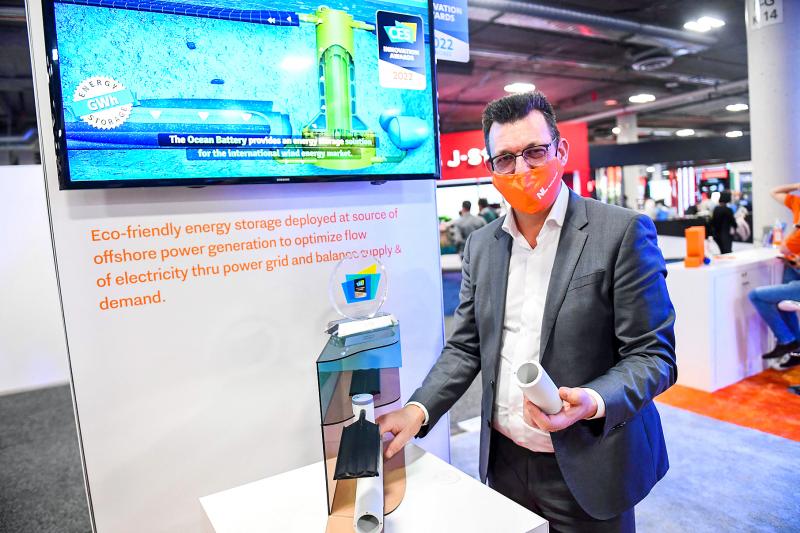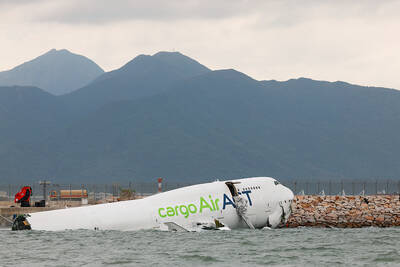A wind turbine sitting idle on a calm day or spinning swiftly when power demand is already met poses a problem for renewables, and is one researchers think can be tackled under the sea.
In one vision, offshore wind farms could use seawater to essentially store energy until it is needed, helping wean humanity off fossil fuels.
“We came up with a solution that we call the ocean battery,” Frits Bliek, CEO of Dutch start-up Ocean Grazer, said while showing off the system at the Consumer Electronics Show in Las Vegas.

Photo: AFP
Amid the growing push away from climate-warming energy sources such as coal, stockpiling green energy is key, experts say.
That is because nature does not always deliver wind — or sun — at the moment when electricity is most in demand.
Bliek’s “ocean battery” relies on massive flexible bladders on the seabed, which are filled with seawater by the wind farm.
When the power is needed, the pressure of the ocean squeezes the water through the system on the seafloor that includes turbines — and the result is electricity.
A key consideration with energy is cost, and storage systems involving some type of battery are not only very expensive, but also at risk of leaks or contamination in an ocean environment.
Systems that rely on pressure are already used in hydroelectric dams that pump water into the reservoir behind the dam when electricity demand falls, effectively storing it to come back through the facility’s turbines.
The US Department of Energy traces the concept, called “pumped storage hydropower,” to Italy and Switzerland in the 1890s, although facilities can be found all around the world.
As for the underwater version of this type of storage, Ocean Grazer is not alone in trying to make it work.
FLASC, a spin-off of the University of Malta, has a system that uses renewably made electricity to pump water into a chamber that contains under-pressure air, which can then turn a hydraulic turbine to generate power.
Another initiative called StEnSea (Stored energy in the sea), uses hollow concrete spheres under the pressure of the deep ocean, and was tested in a German lake in 2016.
Bliek, the Ocean Grazer CEO, said undersea systems take advantage of the pressure below the ocean that is free, while creating a system that he said is about 80 percent efficient in storing energy.
He sees storage systems as key for renewables, which have boomed as the price to produce such energy has dropped and made them a steadily growing part of the energy mix worldwide.
Renewables are the fastest-growing source in the US, increasing 42 percent from 2010 to 2020, according to the nonprofit Center for Climate and Energy Solutions.
Deploying systems like the “ocean battery” on the scale needed to work as part of an electricity grid is still years away.
Bliek said his company aims to have an offshore system in place by 2025, although one will be deployed onshore in the northern Netherlands by next year.
Although various aspects of energy storage through pressure are not new, the pairing of it with green energy sources carries significant potential.
“With wind and solar now becoming part of the grid — basically allowing us to get rid of fossil fuels — in that context this is very exciting,” said Claudio Canizares, an engineering professor and renewables expert at the University of Waterloo in Canada.

A missing fingertip offers a clue to Mako Nishimura’s criminal past as one of Japan’s few female yakuza, but after clawing her way out of the underworld, she now spends her days helping other retired gangsters reintegrate into society. The multibillion-dollar yakuza organized crime network has long ruled over Japan’s drug rings, illicit gambling dens and sex trade. In the past few years, the empire has started to crumble as members have dwindled and laws targeting mafia are tightened. An intensifying police crackdown has shrunk yakuza forces nationwide, with their numbers dipping below 20,000 last year for the first time since records

EXTRADITION FEARS: The legislative changes come five years after a treaty was suspended in response to the territory’s crackdown on democracy advocates Exiled Hong Kong dissidents said they fear UK government plans to restart some extraditions with the territory could put them in greater danger, adding that Hong Kong authorities would use any pretext to pursue them. An amendment to UK extradition laws was passed on Tuesday. It came more than five years after the UK and several other countries suspended extradition treaties with Hong Kong in response to a government crackdown on the democracy movement and its imposition of a National Security Law. The British Home Office said that the suspension of the treaty made all extraditions with Hong Kong impossible “even if

CAUSE UNKNOWN: Weather and runway conditions were suitable for flight operations at the time of the accident, and no distress signal was sent, authorities said A cargo aircraft skidded off the runway into the sea at Hong Kong International Airport early yesterday, killing two ground crew in a patrol car, in one of the worst accidents in the airport’s 27-year history. The incident occurred at about 3:50am, when the plane is suspected to have lost control upon landing, veering off the runway and crashing through a fence, the Airport Authority Hong Kong said. The jet hit a security patrol car on the perimeter road outside the runway zone, which then fell into the water, it said in a statement. The four crew members on the plane, which

Japan’s ruling Liberal Democratic Party (LDP) and its junior partner yesterday signed a coalition deal, paving the way for Sanae Takaichi to become the nation’s first female prime minister. The 11th-hour agreement with the Japan Innovation Party (JIP) came just a day before the lower house was due to vote on Takaichi’s appointment as the fifth prime minister in as many years. If she wins, she will take office the same day. “I’m very much looking forward to working with you on efforts to make Japan’s economy stronger, and to reshape Japan as a country that can be responsible for future generations,”